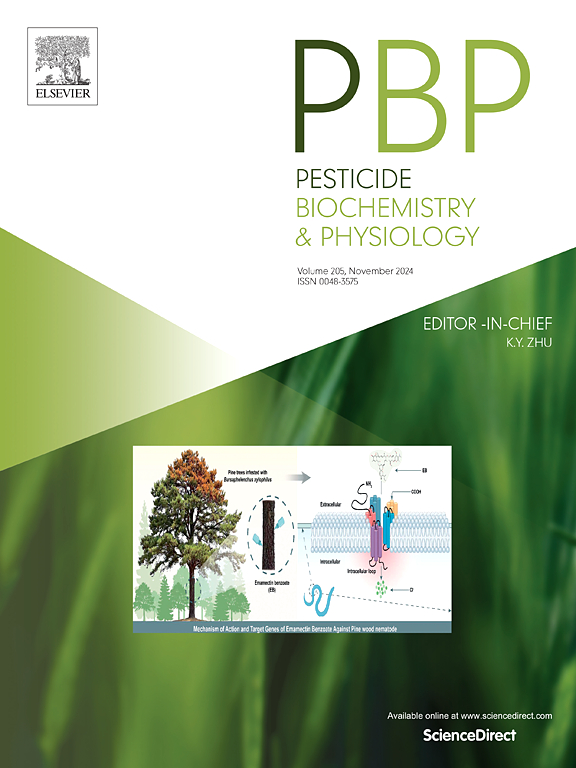Risk assessment and resistant mechanism of Fusarium graminearum to fluopyram
IF 4.2
1区 农林科学
Q2 BIOCHEMISTRY & MOLECULAR BIOLOGY
引用次数: 0
Abstract
Fusarium head blight (FHB), caused by the Fusarium graminearum species complex, poses a significant threat to global wheat production and human health due to its high virulence and the ability to produce harmful secondary metabolites. Although various fungicides have been extensively used to control FHB, there is a critical need for more comprehensive information on the resistance of F. graminearum to fluopyram in China. This study evaluated the sensitivity of F. graminearum strains collected from five distinct regions to fluopyram. The EC50 values for fluopyram ranged from 1.20 to 6.42 μg/mL, with an average value of 3.30 μg/mL. Additionally, fluopyram-resistant mutants were generated in the laboratory by chemical taming, with a resistance frequency of 8.3 × 10-−3. Furthermore, no significant differences were observed in conidiation, growth rate, and temperature sensitivity between the resistant mutants and the parental strains. It was also determined that fluopyram exhibits positive cross-resistance with pydiflumetofen but no cross-resistance with carbendazim, tebuconazole, and pyraclostrobin. The mutations associated with fluopyram resistance in F. graminearum were identified as SDHB-H248L, SDHC2-A83V, and SDHC2-R86K. Based on these findings, the risk of resistance development in F. graminearum to fluopyram was assessed as moderate. Additionally, it was found that the combination of prothioconazole and fluopyram is more effective than their individual use in field trials. Considering the role of fluopyram in inhibiting DON produced by F. graminearum, it is recommended that fluopyram be used in conjunction with other highly effective fungicides to control FHB, thereby achieving both disease control and mycotoxin reduction.
谷草镰刀菌对氟吡喃的抗性机制及风险评估
镰刀菌头疫病(Fusarium head blight, FHB)是由谷草镰刀菌(Fusarium graminearum)菌种复合物引起的疫病,由于其高毒力和产生有害次生代谢物的能力,对全球小麦生产和人类健康构成重大威胁。尽管各种杀菌剂已被广泛用于控制FHB,但中国迫切需要更全面的关于F. graminearum对氟吡喃耐药性的信息。本研究评估了从5个不同地区收集的禾谷F. graminearum菌株对氟吡喃的敏感性。氟吡喃的EC50值为1.20 ~ 6.42 μg/mL,平均值为3.30 μg/mL。此外,在实验室中通过化学驯化产生了氟吡喃抗性突变体,抗性频率为8.3 × 10- 3。此外,抗性突变体与亲本菌株在分生、生长速率和温度敏感性方面均无显著差异。还确定氟吡仑与吡氟甲醚呈阳性交叉耐药,但与多菌灵、戊康唑和吡氯菌酯无交叉耐药。与氟吡姆耐药性相关的突变分别为SDHB-H248L、SDHC2-A83V和SDHC2-R86K。基于这些发现,评估禾谷酵母对氟吡喃产生耐药性的风险为中等。此外,在田间试验中发现,原硫康唑和氟吡仑联合使用比单独使用更有效。考虑到氟吡喃在抑制F. graminearum产生DON中的作用,建议氟吡喃与其他高效杀菌剂联合使用来控制FHB,从而达到控制疾病和减少霉菌毒素的双重目的。
本文章由计算机程序翻译,如有差异,请以英文原文为准。
求助全文
约1分钟内获得全文
求助全文
来源期刊
CiteScore
7.00
自引率
8.50%
发文量
238
审稿时长
4.2 months
期刊介绍:
Pesticide Biochemistry and Physiology publishes original scientific articles pertaining to the mode of action of plant protection agents such as insecticides, fungicides, herbicides, and similar compounds, including nonlethal pest control agents, biosynthesis of pheromones, hormones, and plant resistance agents. Manuscripts may include a biochemical, physiological, or molecular study for an understanding of comparative toxicology or selective toxicity of both target and nontarget organisms. Particular interest will be given to studies on the molecular biology of pest control, toxicology, and pesticide resistance.
Research Areas Emphasized Include the Biochemistry and Physiology of:
• Comparative toxicity
• Mode of action
• Pathophysiology
• Plant growth regulators
• Resistance
• Other effects of pesticides on both parasites and hosts.

 求助内容:
求助内容: 应助结果提醒方式:
应助结果提醒方式:


